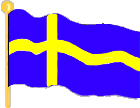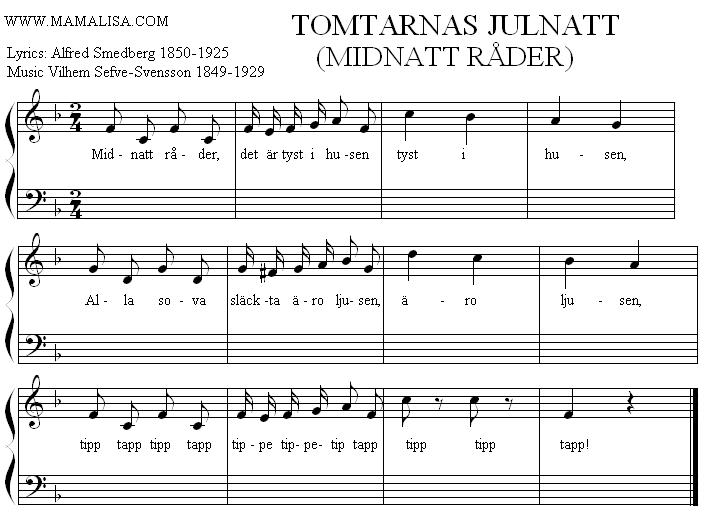Tomtarnas Julnatt
Here is a children's song and Christmas song which draws on the old folk superstition about "tomtar" (singular "tomte"), a kind of tiny, benevolent elf or gnome that liked to take up residence near or under houses that were close to a forest, and tended to be occasionally useful to the inhabitants of the house if they treated it well. Typically, they would help lost sheep find their way home, and the like. Tomtar presumably lived off nuts and berries, but in the winter when these were hard to find, it was customary to set out a bowl of porridge outside the front door late in the evening, so that the local tomte had something to eat. Especially around Christmas. On Christmas Eve, it was customary in remote farms to set the dining table for a feast, and leave it overnight. The local tomte as well as ones from neighbouring houses and from the forest would then sneak in and eat whatever they wanted during the night, and then the people of the house would eat the next day. This song is about a gang of tomtar visiting on a Christmas night.
Every verse ends with the nonsense sequence "tipp, tapp, tipp, tapp, tippetippetipp tapp! Tipp, tipp, tapp", the sound of small feet tiptoeing around. I've left it out of the text below.
Tomtarnas Julnatt
The Gnomes' Christmas Night
Christmas Carol
Christmas Carol
(Swedish)
(English)
Midnatt råder,
tyst det är i husen,
tyst i husen.
Alla sover,
släckta äro ljusen,
äro ljusen.
Se, då krypa
tomtar upp ur vrårna
upp ur vrårna,
lyssna, speja,
trippa fram på tårna,
fram på tårna.
Snälla folket
låtit maten rara,
maten rara,
stå på bordet
åt en tomteskara,
tomteskara.
Hur de mysa,
hoppa upp bland faten,
upp bland faten,
tissla, tassla¹,
"God är julematen,
julematen!"
Gröt och skinka,
lilla äppelbiten,
äppelbiten,
tänk så rart
det smakar Nisse² liten,
Nisse² liten.
Nu till lekar!³
Glada skratten klingar,
skratten klingar,
runt om granen³
skaran muntert svingar,
muntert svingar.
Natten lider.
Snart de tomtar snälla,
tomtar snälla,
kvick och näpet
allt i ordning ställa,
ordning ställa.
Sedan åter
in i tysta vrårna,
tysta vrårna,
tomteskaran
tassar lätt på tårna,
lätt på tårna.
Midnight reigns,
It's quiet in the houses,
Quiet in the houses.
Everyone sleeps,
The candles are put out,
Candles put out.
Look, there comes
The gnomes out from the corners,
From the corners,
List'ning, watching,
Sneaking on their toes,
On their toes.
The nice people
Have left the sweet food,
The sweet food,
On the table
For a band of gnomes,
Band of gnomes.
How they frolic,
Skipping between dishes,
Between dishes,
Whisper, murmur¹
"It's good, the Christmas food,
Christmas food."
Porridge, ham,
The little piece of apple,
Piece of apple,
Ah how sweet
It tastes for little Gnomie²,
Little Gnomie².
Now the games!³
Happy laughter sounding,
Laughter sounding,
'Round the tree³
The gang merrily swings,
Merrily swings.
Night is ending.
Soon the friendly gnomes,
Friendly gnomes,
Quickly, neatly,
Putting all in order,
All in order.
Then, back
Into the quiet corners,
Quiet corners,
The gang of gnomes
Sneak on their toes,
On their toes.
Notes
¹ The Swedish words "tissla" and "tassla" are not exactly real words, but rather both onomatopoeic slang for whisper, murmur, with a suggestion of secrecy, connivance, urgency, or delight.
² "Nisse" is the standard nickname for someone whose name is "Nils", but also a variation on "tomte". (The word "nisse", however, was also used for a fairytale creature similar to the "tomte", but who was not necessarily benevolent. Perhaps somewhat like the Irish-style leprechaun.) In this instance, "Nisse" is used as a substitute for the nisse's real name, which is not known. Names were magical in the old superstition, and supernatural creatures in particular were generally unwilling to reveal their real names. In the case of this song, it is hard to say if "Nisse" is used deliberately in keeping with this superstition, or just happened to be the writer's convenient way of naming a nisse. "Gnomie" is a mediocre compromise between these possibilities.
³ In cases when the room was large enough to allow it, dancing in a circle around the Christmas tree, singing songs like this one, was a traditional Christmas game for children. In more modern tradition, this practice still lives at larger Christmas parties for children, typically in elementary schools, the little leagues of various sports, etc, after eating but before distributing presents.
*****
Lyrics: Alfred Smedberg (1850 - 1925)
Music: Vilhem Sefve-Svensson (1849 - 1929)
*****

Thanks and Acknowledgements
I am very grateful to Leif Stensson of Project Runeberg for contributing and translating this song and also for providing such interesting commentary. Thanks also to Edward M. Gawlinski for creating the midi music.
Project Runeberg is an open, voluntary project whose purpose is to make classic Nordic literature and art available in electronic form to the public, free of charge.
Thanks also to Bob Barker for his excellent proofing abilities!
Tack så mycket!

























